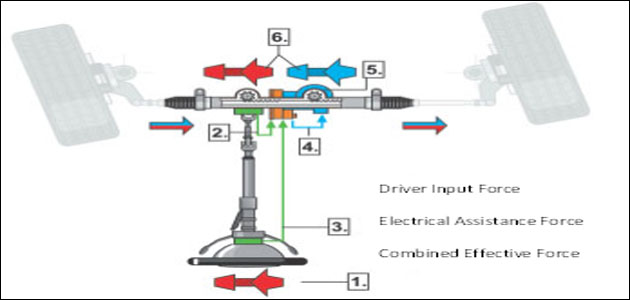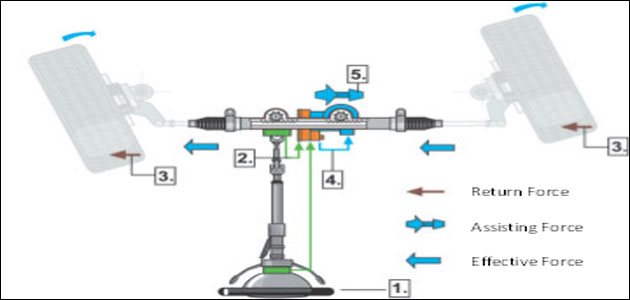
Both the assisted rack and column systems, with the assisting motor placed in different locations, work on similar principles (see image below).

Electrical Assist Steering
The power steering assistance starts when the driver uses force to turn the steering wheel. The force on the steering wheel causes a torsion bar within the steering gear to turn and this motion is detected and sent to the steering ECU. A steering angle sensor sends the steering wheel position and turn rate to the steering ECU.
Depending on the steering force, road speed (which has been received via CAN bus) and different steering maps stored within the steering ECU, the necessary steering assistance force is calculated and actuates the motor accordingly. The steering assistance then imparts its power onto either steering rack or the steering column – dependant on the system.
The sum of the turning force on the steering wheel and the electrical motor assist force is the effective force applied to the steering gear to turn the road wheels.
Some vehicles allow for extra steering assistance to be requested manually, typically by a switch on the control panel. This then uses a different map within the ECU to provide enhanced assistance. With electric steering force assist, active return to centre functionality can be incorporated within the system to improve the return to centre of the steering setup. This is shown in the image below.

Active Centring Function
As the driver reduces the force on the steering wheel, the twist on the torsion bar is reduced. Along with the reduced steering force, the change in steering wheel angle and rate of steer change are used to determine a return speed specification.
The return forces are imparted onto the steering wheels from the vehicle/road dynamics. As a result of internal friction within the steering system and suspension setup, the forces can be weak and unable to bring the steering back to the centre position.
The steering ECU calculates the necessary return forces required from the electric motor by evaluating the steering force, road speed, engine speed, steering angle and steering speed along with the map characteristics stored within the ECU.
The motor is then actuated and the road wheels are returned to the straight ahead position. As the steering assistance is not dependant on the engine, assistance is available to a disabled vehicle too, subject to the battery being in suitable condition. This allows a disabled vehicle to be towed and still keep its steering assistance.
In summary, electrically power assisted steering has the ability to improve fuel efficiency and reduce carbon dioxide (CO2) emissions, whilst improving the drivability and reducing driver fatigue. This is coupled with a reduction of weight and eliminated environmental pollution from hydraulic fluid.









